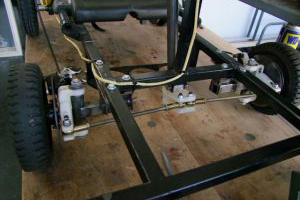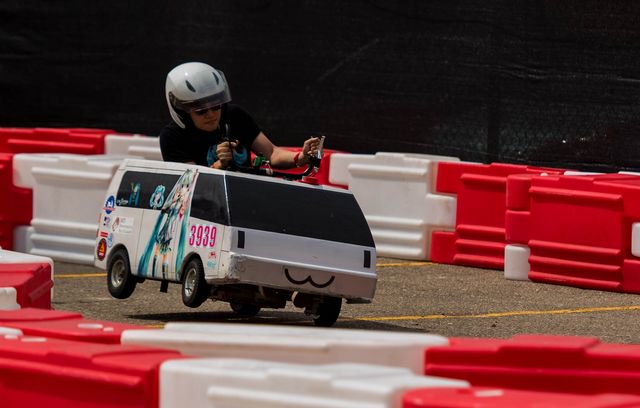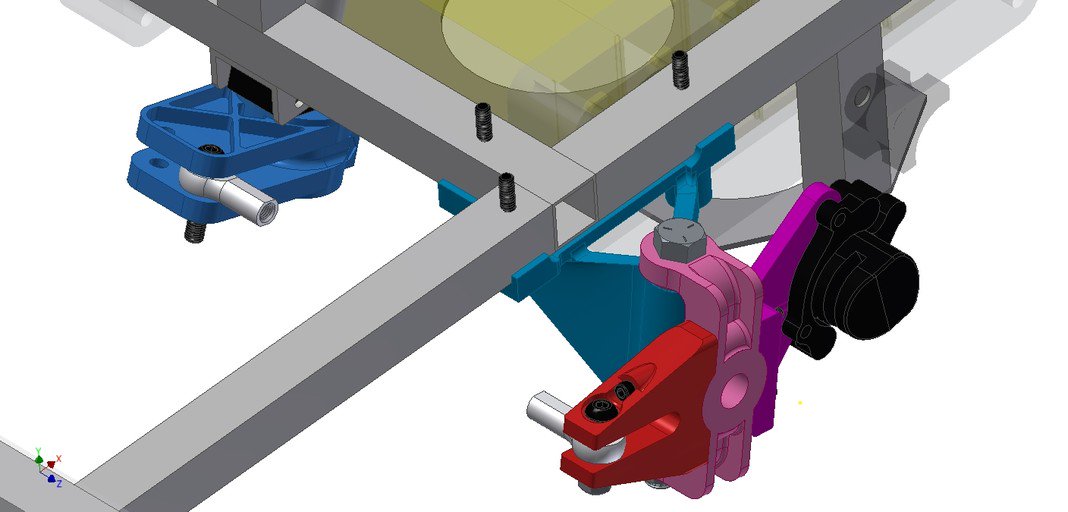3D Printing a Steering Knuckle Strong Enough to Win in Detroit

3...2...1...Go!
A mishmash of Tie Fighters, cardboard Jeeps, and real life MarioKart racers recklessly speed off from the starting line at the Power Racing Series Road Course at the Detroit Maker Faire 2015. Each of these go-karts were built by DIY makers whose creativity, innovation, and goofiness gave their contraptions a chance to shine. Among them is Charles Guan, an MIT graduate with a Bachelor’s Degree in Mechanical Engineering. His concoction of a go-kart is the Chibi-Mikuvan, designed to look like the 1986-1994 Mitsubishi Delica, made from “a hodgepodge of unrelated commercial and industrial parts,” says Guan, including the inrunner motor from an R/C boat and the gearbox of an angle grinder. Built for the previous year’s race, the Chibi-Mikuvan had recently undergone some important upgrades. His modifications to the Chibi-Mikuvan using the Markforged printer helped him secure a victory.

One of the most essential parts of any automotive suspension is the steering knuckle, part of the linkage system that links the yaw of the wheels to the motion of the steering mechanism. The knuckle itself can be a fairly complicated part to manufacture, and has to deal with large forces from all directions, including the resistance from the road, the motion of the tires, and the weight of the driver. Guan wanted to replace his older steering mechanism design, a heavy, failure prone, metal assembly, with something lighter, easier to manufacture, and just as strong.
Designing to Win
When it comes to reducing weight and simplifying the fabrication process, 3D printing combines the quick, iterative design flow of rapid prototyping with the inexpensive yet complex additive manufacturing process. This allows for intricate, precisely dimensioned parts that would otherwise take hours to toil over in a traditional machine shop. Additive manufacturing provided Guan with an opportunity to vastly reduce the weight and bulk of his steering mechanism, but many 3D printing solutions produce parts that are too weak or too brittle to withstand the forces necessary for a steering knuckle.
When machining or 3D printing parts out of metal, the material properties of the piece are stronger, but nearly isotropic. Using a composite material, the fibers can be oriented such that the material properties can be optimized in certain directions along the part. However, composite materials can take many hours to set up, make, and perfect. The Mark One, with its nylon and composite filament options, provided Guan with just the part strength and manufacturability he needed to design a compact, lightweight steering assembly for the Chibi-Mikuvan’s race at the Detroit Maker Faire.
The Grand Prints
Guan designed the parts to take advantage of the anisotropic nature of the MarkForged prints, printing his parts with nylon and fiberglass. The nylon layers provided flexibility, while the embedded fiberglass provided strength about the layers they were laid down upon. “The new steering knuckle,” Guan explains, ”will be printed flat to have large C-shaped sections of fiber holding onto the axle stub”. The knuckle (shown in light pink in the CAD rendering below) has fiber strands running along the face of the “C”, maximizing the strength on that plane, making the part strong, light, and flexible in all the right directions. The knuckle could have been printed in one piece, but it was split into three, using the direction of the fiber in each part to optimize its strength and flexibility. The other two parts, the brake caliper (shown in purple) and the steering follower link (shown in red), were likewise designed to make use of the fiber direction to improve the part. Guan’s new improvements reduced the weight of the bracket’s weight by 40% and made for a more reliable steering assembly.

Printing the parts on the Mark One took about 24 hours. Guan then assembled and tested his new design, jumping on the Chibi-Mikuvan’s frame to make sure it could withstand the forces he needed it to. In his first iteration of the design, Guan said that he “caused Version 1 of the kingpin bracket to buckle the fiber region where the part met the frame. It never failed...” The buckling only caused the wheel to twist a bit more. After slightly modifying the design, he went to testing again.

After the test, Guan explained “I think that one of the reasons it survives is that the nylon is very flexible. It takes quite a lot of shock. If I steer very hard, the whole bracket moves a little bit. I am deforming it right now with about 40 pounds of force and the assembly takes it.” The flexibility of the nylon and fiberglass parts lets the steering assembly absorb hard impacts, allowing it to easily handle an estimated torque of 5 N-m on the face of the axle stub. Confident in his design, Guan sped his way to first place.
“I drove this thing off a curb several times at full speed to try and break these parts...In Detroit, there was no failure and I drove like crazy in the race.”

3D Printing a Steering Knuckle Strong Enough to Win in Detroit
2 Responses
Your internet site has excellent material. I bookmarked the site
Thanks
Comments are closed.